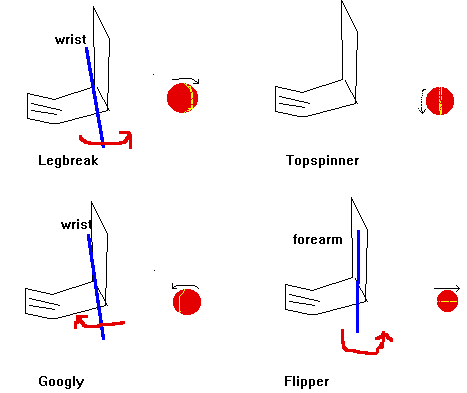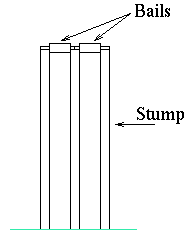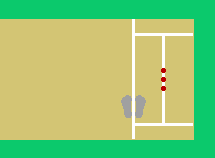Bowling Styles
There are two basic approaches to bowling: fast and spin. A fast bowler bowls the ball as fast as practicable, attempting to defeat the batsman with its pace. If the ball also swings in the air, or seams (moves sideways) off the pitch because of bouncing on the seam, it can be very difficult to play. A spin bowler has a more ambling run-up and uses wrist or finger motion to impart a spin to the ball. The ball then spins to one side when it bounces on the pitch, thus also hopefully causing it to be hard to hit. Fast bowlers are generally used with a new ball, while spin bowlers get more spin with a worn ball. There is also medium pace bowling, which concentrates more on swing and seam than pace.
A swing bowler will hold the seam of the ball at a certain angle and attempt to release the ball so that it spins with the seam at a constant angle. With one side of the ball polished and the other rough, differential air pressure will cause it to swing in the air.
A seam bowler attempts to keep the seam vertical, so that the ball hits the seam when it bounces on the pitch and deflects in its path either to the right or left.
A fast bowler can also pull his fingers down one side of the ball as he lets it go, imparting a small amount of sideways spin to the ball. This can cause the ball to move sideways off the pitch. Such a delivery is called a leg-cutter if the ball moves from the leg side to the off side of a right-handed batsman, or an off-cutter if moves from the off to the leg. A specialist spin bowler can get a lot more spin that a fast bowler bowling cutters, however.
There are two types of spin bowling: off-spin, and leg-spin. Imagine holding a ball in your right hand and, for simplicity's sake, throwing it. If you twist your hand in a clockwise direction on release, then the spin on the ball will be such that when it bounces it will spin to your right. This is essentially off-spin bowling (so called because, to a right-handed batsman, the ball spins from the off side to the leg side). The off-spin delivery itself is called either an off-spinner or an off-break. An off-spin bowler will sometimes not spin the ball so much, putting more pace on the delivery. Such a delivery is called an arm-ball.
Now imagine twisting the ball anticlockwise and releasing it from the palm so that it `rolls' over the base of the little finger. This gives the ball spin in the opposite direction, so it spins left when it bounces. This is basic leg-spin (because to a right-handed batsman it spins from leg to off). The basic leg-spin delivery is called a leg-spinner or leg-break.
The interesting thing about leg-spin is that if you cock your wrist at various angles you can in fact, with the same basic bowling action, produce spin in different directions. With the wrist cocked a little towards the inside of the arm, you can produce top-spinners. Go further and you actually end up producing spin in the same direction as an off-spinner. A ball bowled in this way by a leg-spin bowler is called a wrong 'un, or sometimes a googly . Probably trickiest of all is a ball bowled with the hand in the same position as a top-spinner, but released from under the hand, thereby gaining back-spin. This ball is called a flipper.
The following diagram shows a view of a (right-handed) leg-spinner's arm, from in front (i.e. batsman's point of view). The rotation of the ball out of the hand is the same in each case, with the ball spinning with the seam as an ``equator''.

So right handed spinners fall into two classes: off-spinners, with their simple off-spin and arm-ball deliveries; and leg-spinners, with their leg-spinners, top-spinners, wrong 'uns, and flippers. Leg-spinners are naturally much more difficult to bat against, because of the great variety of balls they can produce, but they are actually rarer than off-spinners because it is so much more difficult to bowl reasonably accurately with the leg-spin hand action.
For left-handed spin bowlers there is a whole different system of nomenclature!
A left-handed bowler who uses the same action as an off-spinner is called an orthodox spinner. Such bowlers are not uncommon. A left-hander who bowls with the same action as a leg-spinner is called an unorthodox spinner - and these are the rarest bowlers in cricket. The left-handed analogue of the leg-spin delivery (which spins the opposite way, of course) is called an unorthodox spinner. The top-spinner and flipper retain their names. And the left-handed analogue of the wrong 'un is called a Chinaman .
Typical bowling speeds are:
Fast bowler:
130-140 km/h (80-90 mph)
Medium pace bowler:
100-130 km/h (60-80 mph)
Spin bowler:
70-90 km/h (45-55 mph)
Bowlers also make use of the state of the pitch, which is quite crucial to the game, and is one of the things the commentators look at in great detail before the game begins. Because it's a natural surface, there are usually small inconsistencies in its flatness, hardness and elasticity. Over a multi-day game, or even over a single day, these become more pronounced, so it often gets more difficult to bat as the game progresses. Spin bowlers in particular often find that they get much more spin from an old pitch than a freshly prepared one.
Some of the different types of balls bowled have special names:
Bouncer:
A ball bounced short so that it bounces high, usually chest height or higher as it passes the batsman.
Yorker:
A ball bounced very close to the batsman's crease. This is difficult to score from and often gets batsmen out, but is difficult to bowl without accidentally bowling a full toss.




